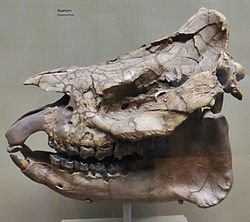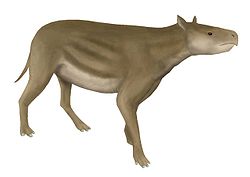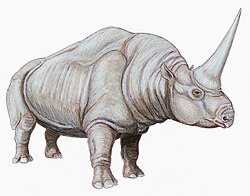Ace Atkins
| Prosantorhinus Temporal range: Miocene
| |
|---|---|

| |
| Scientific classification | |
| Domain: | Eukaryota |
| Kingdom: | Animalia |
| Phylum: | Chordata |
| Class: | Mammalia |
| Order: | Perissodactyla |
| Family: | Rhinocerotidae |
| Subfamily: | †Aceratheriinae |
| Genus: | †Prosantorhinus Heissig, 1973[1] |
| Species | |
|
Prosantorhinus douvillei | |
Prosantorhinus is an extinct genus of rhinocerotid that lived during the Early and Middle Miocene subepochs. The small teleoceratine rhinocerotid was found in Western Europe and Asia.[2]
Description
Prosantorhinus was a similarly sized animal to the Sumatran rhinoceros, it stood at around 4 ft 3 in (130 cm) at the shoulder and was about 9 ft 6 in (290 cm) long, weight estimates however are considerably bigger due to its considerably deeper chest.[3] The body plan of Prosantorhinus is stubbier than that of other rhinocerotids, and its brachyodont molars would seem to suggest Prosantorhinus led a semiaquatic life, similar to a hippopotamus, possibly feeding on fresh water plants.[4][5] The tooth eruption sequence of P. germanicus was identical to that of the present-day black rhinoceros, suggesting that it was a slow-growing and long-lived mammal.[6] The rugged texture at the tip of its snout could suggest the existence of one, maybe two, small horns; however it has been traditionally reconstructed with a fleshy bump.[7]
Palaeoecology
Study of the dental mesowear and microwear of P. douvillei reveals that it was a folivorous browser.[8]
References
- ^ "Prosantorhinus". Fossilworks.
- ^ Antoine, P-O.; Bulot, C.; Ginsburg, L. (2000). "Une faune rare de rhinocérotidés (Mammalia, Perissodactyla) dan le Miocène inférieur de Pellecahus (Gers, France)". Geobios. 33 (2): 249–255. Bibcode:2000Geobi..33..249A. doi:10.1016/S0016-6995(00)80022-4.
- ^ Hernández Fernández, Manuel; Ansón, Marco. "Artistic reconstruction of the appearance of Prosantorhinus Heissig, 1974, the teleoceratine rhinoceros from the Middle Miocene of Somosaguas". ResearchGate. Spanish Journal of Paleontology. Retrieved 23 September 2021.
- ^ Agustí, Jordi; Antón, Mauricio (2002). Mammoths, Sabertooths, and Hominids: 65 Million Years of Mammalian Evolution in Europe. Columbia University Press. p. 113. ISBN 9780231116411.
- ^ Heissig, K. (1999): Family Rhinocerotidae. - In: Rossner, G. E. & Heissig, K. (Eds.): The Miocene Land Mammals of Europe, 175-188; Munich (Pfeil).
- ^ Böhmer, Christine; Heissig, Kurt; Rössner, Gertrud E. (9 November 2015). "Dental Eruption Series and Replacement Pattern in Miocene Prosantorhinus (Rhinocerotidae) as Revealed by Macroscopy and X-ray: Implications for Ontogeny and Mortality Profile". Journal of Mammalian Evolution. 23 (3): 265–279. doi:10.1007/s10914-015-9313-x. ISSN 1064-7554. Retrieved 14 November 2024 – via Springer Link.
- ^ Cerdeño, Esperanza (1996-01-01). "Prosantorhinus, the small teleoceratinerhinocerotid from the Miocene of Western Europe". Geobios. 29 (1): 111–124. Bibcode:1996Geobi..29..111C. doi:10.1016/S0016-6995(96)80077-5. ISSN 0016-6995. Retrieved 2021-09-21.
- ^ Hullot, Manon; Laurent, Yves; Merceron, Gildas; Antoine, Pierre-Olivier (2021). "Paleoecology of the Rhinocerotidae (Mammalia, Perissodactyla) from Béon 1, Montréal-du-Gers (late early Miocene, SW France): Insights from dental microwear texture analysis, mesowear, and enamel hypoplasia". Palaeontologia Electronica. doi:10.26879/1163. Retrieved 29 November 2024.

 Read
Read
 AUTHORPÆDIA is hosted by Authorpædia Foundation, Inc. a U.S. non-profit organization.
AUTHORPÆDIA is hosted by Authorpædia Foundation, Inc. a U.S. non-profit organization.








